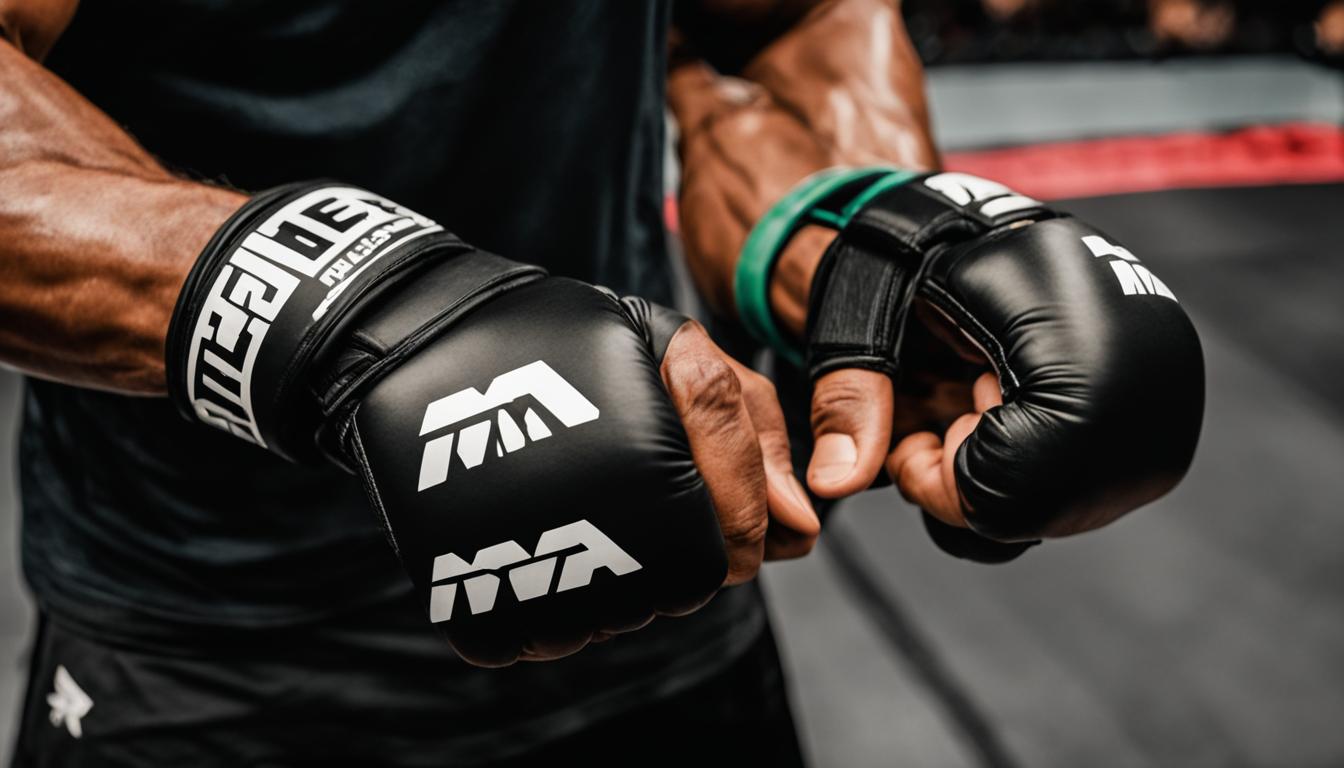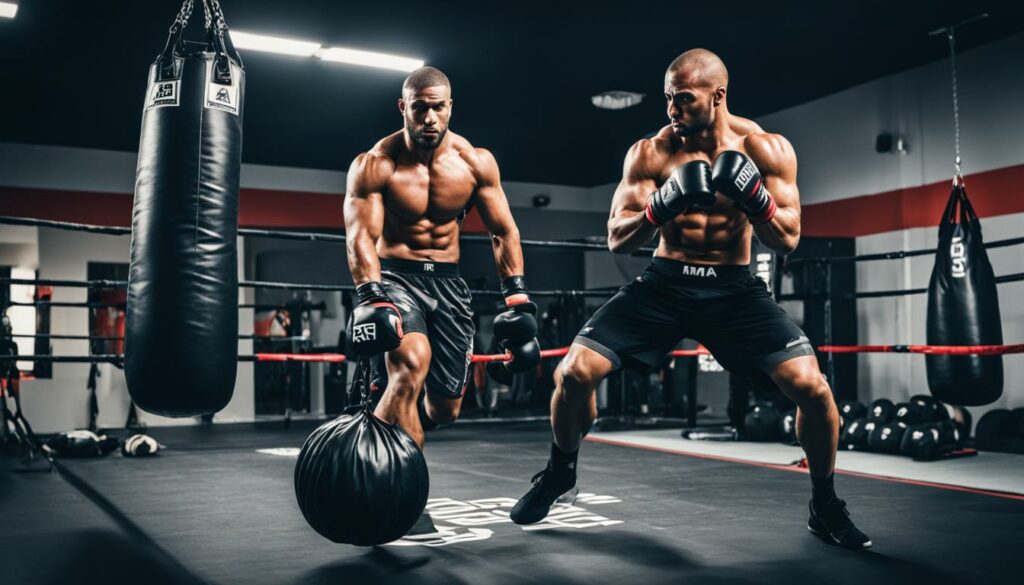If you’re looking to get into MMA in 2024, there are some essential tips to keep in mind. Whether you’re a beginner or have some experience, having the right training and preparation is key to success in this dynamic and challenging sport.
First and foremost, finding the right MMA training facility is crucial. Look for reputable and well-established MMA gyms that offer classes and programs tailored to beginners. These gyms provide expert coaches who can teach you proper techniques, help you improve your skills, and guide you through your MMA journey.
Once you’ve found a suitable gym, it’s important to have a well-rounded workout routine. This includes a combination of cardio training, fight sessions, and targeted strength training. Cardio workouts, such as running or swimming, help improve your endurance and stamina in the ring.
During fight sessions, you’ll practice various techniques and drills that simulate real fight scenarios. This allows you to develop your striking, grappling, and defensive skills. Incorporating targeted strength training exercises will help build the necessary muscle strength and explosiveness for powerful strikes and takedowns.
Remember that proper nutrition is also a crucial aspect of MMA training. Maintaining a balanced diet that includes lean proteins, healthy fats, and plenty of fruits and vegetables will fuel your body and support optimal performance.
Lastly, don’t forget to invest in the appropriate MMA gear. This includes hand wraps, gloves, shin guards, and a mouthguard to protect yourself during training and competitions.
Key Takeaways:
- Choosing a reputable MMA gym is essential for beginners.
- A well-rounded workout routine should include cardio, fight training, and targeted strength training.
- Proper nutrition is crucial for optimal performance in MMA.
- Invest in high-quality MMA gear to protect yourself during training and competitions.
- Always consult with a professional coach or trainer to ensure safe and effective training.
The Role of Strength Training in MMA
Strength training is a crucial component of MMA training, helping fighters enhance their performance in the ring. However, it’s important to approach strength training in MMA differently compared to traditional weightlifting routines. While building muscle is essential, fighters should prioritize agility, speed, and endurance over pure size. Heavy weightlifting can hinder punching ability and speed, so it’s advisable to keep the weight low and intensity high.
By incorporating a mix of cardiovascular training, fight sessions, and targeted strength exercises, fighters can develop the physical attributes necessary to excel in MMA. This includes enhancing agility, explosiveness, and endurance. Fast-twitch muscles, which are responsible for quick and powerful movements, can be developed through high-intensity strength training exercises.
Building a well-rounded physique through strength training allows fighters to execute swift strikes, explosive takedowns, and rapid transitions on the ground. It also aids in overcoming fatigue during fights, enabling fighters to maintain a high level of performance for longer durations. Furthermore, strength training plays a vital role in injury prevention by strengthening tendons, ligaments, and bones.
Sample Strength Training Program for MMA:
Here’s a sample strength training program designed to build muscle, agility, speed, and endurance for MMA fighters:
| Exercise | Reps | Sets |
|---|---|---|
| Deadlift | 6-8 | 3 |
| Dumbbell Step-Ups | 10-12 (each leg) | 3 |
| Plyometric Push-Ups | 10-12 | 3 |
| Kettlebell Swings | 15-20 | 3 |
| Battle Rope Slams | 30 seconds | 3 |
This program incorporates compound exercises like deadlifts and dumbbell step-ups to build overall strength and power. Plyometric push-ups help improve fast-twitch muscle fibers, while kettlebell swings and battle rope slams enhance endurance and explosiveness. It’s important to note that proper form and technique should always be prioritized to prevent injuries.
“Strength training for MMA is not about becoming the biggest or strongest person in the gym. It’s about building functional strength, agility, speed, and endurance to optimize performance inside the cage.” – Joe Rogan
The Importance of Cardio Training in MMA
Cardio training is crucial for MMA fighters to optimize their performance in the ring. It allows them to control their heart rate, increase endurance, and build mental and physical resilience. MMA fighters need to be able to withstand the intense demands of the sport, both mentally and physically, for extended periods of time. Without dedicated cardio training, fighters are at risk of experiencing mental stress and physical fatigue, which can significantly impact their performance.
Regular cardio workouts, such as cardio boxing or shadowboxing, are essential for building mental toughness and improving endurance. These exercises simulate the fast-paced and intense nature of MMA fights, preparing fighters for the rigorous physical demands they will face in the ring. By incorporating cardio training into their routine, fighters can develop the necessary mental and physical stamina required to excel in MMA.
One of the primary benefits of cardio training in MMA is the ability to control heart rate during intense bouts. This control enables fighters to maintain a steady and efficient cardiovascular system, ensuring optimal performance and preventing premature exhaustion. By consistently challenging their cardiovascular limits through cardio training, fighters can improve their heart’s ability to pump oxygenated blood to the muscles, delaying the onset of fatigue.
The mental benefits of cardio training are equally important in MMA. By pushing through mental barriers during intense cardio workouts, fighters develop mental toughness and resilience, allowing them to stay focused and composed during fights. Mental fatigue can be just as detrimental as physical fatigue, and cardiovascular conditioning plays a significant role in maintaining mental clarity and sharpness throughout a match.
Here is an example of a cardio training routine for MMA fighters:
- 30 minutes of high-intensity interval training (HIIT), alternating between 30 seconds of all-out effort and 30 seconds of active rest.
- 20 minutes of jump rope exercises to improve footwork and overall agility.
- 10 rounds of shadowboxing, focusing on maintaining proper technique while maintaining a high tempo.
- Finish with a cool-down period of light jogging or cycling to gradually lower the heart rate.
Incorporating regular cardio training into the overall training regimen is essential for MMA fighters to enhance their endurance, control heart rate, and effectively manage mental and physical fatigue. Only through consistent cardio training can fighters develop the necessary attributes to excel in the sport and achieve success in MMA.
The Challenges Faced by Independent MMA Promoters
Independent MMA promoters encounter a multitude of challenges within the industry. These challenges include dealing with canceled events, fights falling apart at the last minute, and managing financial constraints. Budgets are often tight, and the dominance of established promotions like the UFC makes it difficult for independent promoters to attract a large audience.
In an industry dominated by big names, establishing credibility and garnering attention can be an uphill battle for independent promoters. Limited resources and lack of recognition make it challenging for them to compete with rival promotions. The financial constraints they face further compound the difficulties they encounter.
“Independent MMA promoters face numerous challenges such as canceled events, financial constraints, and rival promotions. Despite these obstacles, these promoters persevere because of their passion for the sport and their commitment to providing opportunities for fighters to showcase their skills.”
Additionally, independent promoters must navigate the complexities of state athletic commissions, ensuring they comply with regulations and licensing requirements. These administrative procedures can be time-consuming and add to the operational challenges faced by independent promoters.
Moreover, rival promotions may actively seek to sabotage events organized by independent promoters in an effort to protect their market share and reputation. This creates a tense and competitive environment for independent MMA promoters, requiring them to be resilient and resourceful.
Despite the many obstacles they encounter, independent promoters continue to persevere due to their passion for the sport and their unwavering determination to provide opportunities for talented fighters to showcase their skills.
Through their relentless dedication and commitment, independent MMA promoters play a vital role in nurturing and developing up-and-coming fighters, contributing to the growth and diversity of the MMA landscape.
When to Start Investing: The Importance of Building a Solid Financial Foundation
Before diving into investing, it’s crucial to establish a solid financial foundation. This includes saving an emergency fund, paying off debt, and having a fully funded emergency fund. By following a step-by-step plan like the 7 Baby Steps, individuals can prioritize their financial goals and gradually work towards them. Investing should only be pursued after achieving financial stability and paying off debt. By doing so, individuals can free up their income and have a stronger financial position to start investing for the future.
Building a solid financial foundation is the core principle when it comes to investing. Without a strong financial base, investing can become risky and hinder long-term financial growth. To ensure financial stability, individuals should follow the Debt Snowball method, which involves paying off debt starting from the smallest balance and then working your way up to larger debts. This approach not only helps alleviate financial stress but also frees up extra income to allocate towards investments.
Additionally, having an emergency fund is essential before considering investing. An emergency fund acts as a safety net, providing financial security in the event of unexpected expenses or life emergencies. By having three to six months’ worth of living expenses saved in an emergency fund, individuals can protect themselves from potential financial setbacks and have peace of mind.
Furthermore, it is crucial to prioritize retirement savings as part of a strong financial foundation. Retirement savings ensure financial security during the golden years and allow individuals to enjoy their desired lifestyles post-work. By starting early and consistently contributing to retirement accounts like 401(k)s or IRAs, individuals can take advantage of compound interest and experience significant growth over time.
| Key Components of Building a Solid Financial Foundation | |
|---|---|
| 1. Paying off Debt | Individuals should prioritize paying off debt, starting from the smallest balance. This approach, known as the Debt Snowball, helps reduce financial stress and frees up income for investments and savings. |
| 2. Establishing an Emergency Fund | Save three to six months’ worth of living expenses in an emergency fund to provide a cushion for unexpected expenses or emergencies. |
| 3. Investing in Retirement | Start saving for retirement early and consistently contribute to retirement accounts to take advantage of compound interest and secure financial stability in the future. |
Conclusion
In conclusion, pursuing a successful career in MMA in 2024 requires a comprehensive training routine that encompasses strength training, cardio workouts, and fight training. It is essential to prioritize agility and endurance over muscle size when it comes to strength training. By focusing on building fast-twitch muscles through targeted exercises, fighters can enhance their speed and power in the ring.
Cardio training plays a vital role in developing endurance and controlling heart rate during intense bouts. Regular cardio workouts, such as cardio boxing or shadowboxing, help fighters build mental toughness and prepare for the grueling demands of MMA. It is crucial to include cardio exercises in the training regimen to ensure optimal performance inside the cage.
Independent MMA promoters face numerous challenges, including canceled events, financial constraints, and competition from larger promotions. However, their unwavering passion for the sport drives them to overcome these obstacles and provide opportunities for fighters to showcase their skills. These promoters play a crucial role in nurturing talent and contributing to the growth of the MMA industry.
When it comes to investing, it is essential to establish a solid financial foundation before delving into the world of investments. By prioritizing financial stability, paying off debts, and building an emergency fund, individuals can position themselves for long-term financial success. Following a step-by-step plan, such as the 7 Baby Steps, will guide individuals towards achieving their financial goals and provide them with the financial freedom to pursue their MMA dreams.


